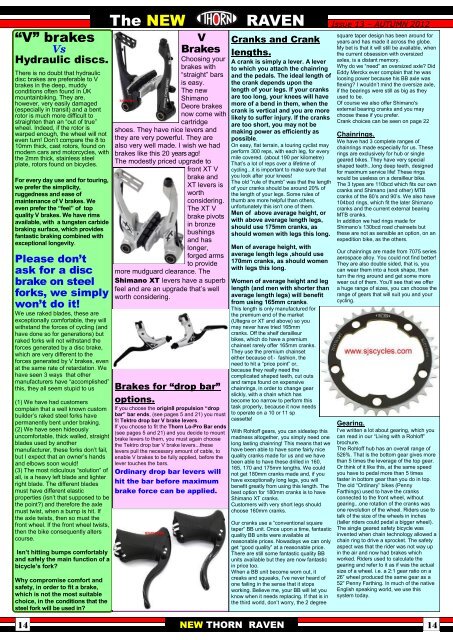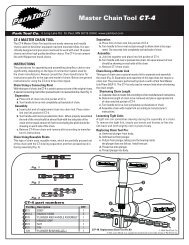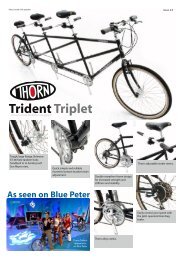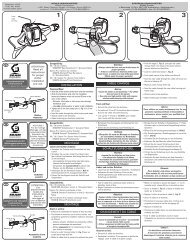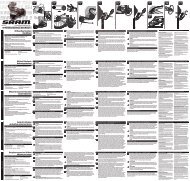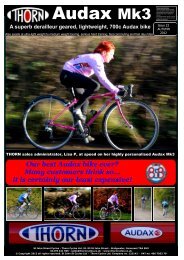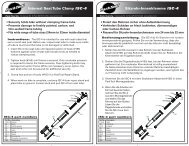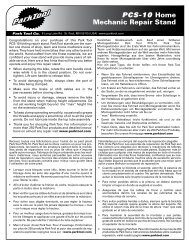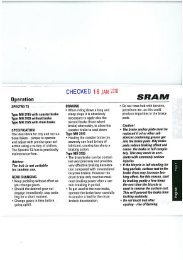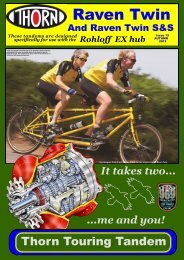You also want an ePaper? Increase the reach of your titles
YUMPU automatically turns print PDFs into web optimized ePapers that Google loves.
“V” brakes<br />
Vs<br />
Hydraulic discs.<br />
There is no doubt that hydraulic<br />
disc brakes are preferable to V<br />
brakes in the deep, muddy<br />
conditions often found in UK<br />
mountainbiking. They are,<br />
however, very easily damaged<br />
(especially in transit) and a bent<br />
rotor is much more difficult to<br />
straighten than an “out of true”<br />
wheel. Indeed, if the rotor is<br />
warped enough, the wheel will not<br />
even turn! Don’t compare the 8 to<br />
10mm thick, cast rotors, found on<br />
modern cars and motorcycles, with<br />
the 2mm thick, stainless steel<br />
plate, rotors found on bicycles.<br />
For every day use and for touring,<br />
we prefer the simplicity,<br />
ruggedness and ease of<br />
maintenance of V brakes. We<br />
even prefer the “feel” of top<br />
quality V brakes. We have rims<br />
available, with a tungsten carbide<br />
braking surface, which provides<br />
fantastic braking combined with<br />
exceptional longevity.<br />
Please don’t<br />
ask for a disc<br />
brake on steel<br />
forks, we simply<br />
won’t do it!<br />
We use raked blades, these are<br />
exceptionally comfortable, they will<br />
withstand the forces of cycling (and<br />
have done so for generations) but<br />
raked forks will not withstand the<br />
forces generated by a disc brake,<br />
which are very different to the<br />
forces generated by V brakes, even<br />
at the same rate of retardation. We<br />
have seen 3 ways that other<br />
manufacturers have “accomplished”<br />
this, they all seem stupid to us<br />
(1) We have had customers<br />
complain that a well known custom<br />
builder’s raked steel forks have<br />
permanently bent under braking.<br />
(2) We have seen hideously<br />
uncomfortable, thick walled, straight<br />
blades used by another<br />
manufacturer, these forks don’t fail,<br />
but I expect that an owner’s hands<br />
and elbows soon would!<br />
(3) The most ridiculous “solution” of<br />
all, is a heavy left blade and lighter<br />
right blade. The different blades<br />
must have different elastic<br />
properties (isn’t that supposed to be<br />
the point?) and therefore the axle<br />
must twist, when a bump is hit. If<br />
the axle twists, then so must the<br />
front wheel. If the front wheel twists,<br />
then the bike consequently alters<br />
course.<br />
Isn’t hitting bumps comfortably<br />
and safely the main function of a<br />
bicycle’s fork?<br />
Why compromise comfort and<br />
safety, in order to fit a brake,<br />
which is not the most suitable<br />
choice, in the conditions that the<br />
steel fork will be used in?<br />
14<br />
The NEW RAVEN<br />
V<br />
Brakes<br />
Choosing your<br />
brakes with<br />
“straight” bars<br />
is easy.<br />
The new<br />
Shimano<br />
Deore brakes<br />
now come with<br />
cartridge<br />
shoes. They have nice levers and<br />
they are very powerful. They are<br />
also very well made. I wish we had<br />
brakes like this 20 years ago!<br />
The modestly priced upgrade to<br />
front XT V<br />
brake and<br />
XT levers is<br />
worth<br />
considering.<br />
The XT V<br />
brake pivots<br />
in bronze<br />
bushings<br />
and has<br />
longer,<br />
forged arms<br />
to provide<br />
more mudguard clearance. The<br />
Shimano XT levers have a superb<br />
feel and are an upgrade that’s well<br />
worth considering.<br />
Brakes for “drop bar”<br />
options.<br />
If you choose the origin8 propulsion “drop<br />
bar” bar ends, (see pages 5 and 21) you must<br />
fit Tektro drop bar V brake levers.<br />
If you choose to fit the <strong>Thorn</strong> Lo-Pro Bar ends<br />
(see pages 5 and 21) and you decide to mount<br />
brake levers to them, you must again choose<br />
the Tektro drop bar V brake levers...these<br />
levers pull the necessary amount of cable, to<br />
enable V brakes to be fully applied, before the<br />
lever touches the bars.<br />
Ordinary drop bar levers will<br />
hit the bar before maximum<br />
brake force can be applied.<br />
Cranks and Crank<br />
lengths.<br />
A crank is simply a lever. A lever<br />
to which you attach the chainring<br />
and the pedals. The ideal length of<br />
the crank depends upon the<br />
length of your legs. If your cranks<br />
are too long, your knees will have<br />
more of a bend in them, when the<br />
crank is vertical and you are more<br />
likely to suffer injury. If the cranks<br />
are too short, you may not be<br />
making power as efficiently as<br />
possible.<br />
On easy, flat terrain, a touring cyclist may<br />
perform 300 reps, with each leg, for every<br />
mile covered. (about 190 per kilometre)<br />
That’s a lot of reps over a lifetime of<br />
cycling...it is important to make sure that<br />
you look after your knees!<br />
The old “rule of thumb” was that the length<br />
of your cranks should be around 20% of<br />
the length of your legs. Some rules of<br />
thumb are more helpful than others,<br />
unfortunately this isn’t one of them.<br />
Men of above average height, or<br />
with above average length legs,<br />
should use 175mm cranks, as<br />
should women with legs this long.<br />
Men of average height, with<br />
average length legs ,should use<br />
170mm cranks, as should women<br />
with legs this long.<br />
Women of average height and leg<br />
length (and men with shorter than<br />
average length legs) will benefit<br />
from using 165mm cranks.<br />
This length is only manufactured for<br />
the premium end of the market<br />
(Ultegra or XT and above) so you<br />
may never have tried 165mm<br />
cranks. Off the shelf derailleur<br />
bikes, which do have a premium<br />
chainset rarely offer 165mm cranks.<br />
They use the premium chainset<br />
either because of:- fashion, the<br />
need to hit a “price point” or,<br />
because they really need the<br />
complicated shaped teeth, cut outs<br />
and ramps found on expensive<br />
chainrings, in order to change gear<br />
slickly, with a chain which has<br />
become too narrow to perform this<br />
task properly, because it now needs<br />
to operate on a 10 or 11 sp<br />
cassette!<br />
With Rohloff gears, you can sidestep this<br />
madness altogether, you simply need one<br />
long lasting chainring! This means that we<br />
have been able to have some fairly nice<br />
quality cranks made for us and we have<br />
been able to have these drilled in 160,<br />
165, 170 and 175mm lengths. We could<br />
not get 180mm cranks made and, if you<br />
have exceptionally long legs, you will<br />
benefit greatly from using this length. The<br />
best option for 180mm cranks is to have<br />
Shimano XT cranks.<br />
Customers with very short legs should<br />
choose 160mm cranks.<br />
Our cranks use a “conventional square<br />
taper” BB unit. Once upon a time, fantastic<br />
quality BB units were available at<br />
reasonable prices. Nowadays we can only<br />
get “good quality” at a reasonable price.<br />
There are still some fantastic quality BB<br />
units available but they are now fantastic<br />
in price too.<br />
When a BB unit become worn out, it<br />
creaks and squeaks, I’ve never heard of<br />
one failing in the sense that it stops<br />
working. Believe me, your BB will let you<br />
know when it needs replacing. If that is in<br />
the third world, don’t worry, the 2 degree<br />
NEW THORN RAVEN<br />
Issue 13 – AUTUMN 2012<br />
square taper design has been around for<br />
years and has made it across the globe.<br />
My bet is that it will still be available, when<br />
the current obsession with oversized<br />
axles, is a distant memory.<br />
Why do we “need” an oversized axle? Did<br />
Eddy Merckx ever complain that he was<br />
loosing power because his BB axle was<br />
flexing? I wouldn’t mind the oversize axle,<br />
if the bearings were still as big as they<br />
used to be.<br />
Of course we also offer Shimano's<br />
external bearing cranks and you may<br />
choose these if you prefer.<br />
Crank choices can be seen on page 22<br />
Chainrings.<br />
We have had 3 complete ranges of<br />
chainrings made especially for us. These<br />
rings are exclusively for hub or single<br />
geared bikes. They have very special<br />
shaped teeth...long deep teeth, designed<br />
for maximum service life! These rings<br />
would be useless on a derailleur bike.<br />
The 3 types are 110bcd which fits our own<br />
cranks and Shimano (and other) MTB<br />
cranks of the 80’s and 90’s. We also have<br />
104bcd rings, which fit the later Shimano<br />
cranks and the current external bearing<br />
MTB cranks.<br />
In addition we had rings made for<br />
Shimano’s 130bcd road chainsets but<br />
these are not as sensible an option, on an<br />
expedition bike, as the others.<br />
Our chainrings are made from 7075 series<br />
aerospace alloy. You could not find better!<br />
They are also double sided, that is, you<br />
can wear them into a hook shape, then<br />
turn the ring around and get some more<br />
wear out of them. You’ll see that we offer<br />
a huge range of sizes, you can choose the<br />
range of gears that will suit you and your<br />
cycling.<br />
Gearing.<br />
I’ve written a lot about gearing, which you<br />
can read in our “Living with a Rohloff”<br />
brochure.<br />
The Rohloff hub has an overall range of<br />
526%. That is the bottom gear gives more<br />
than 5 times the leverage of the top gear.<br />
Or think of it like this, at the same speed<br />
you have to pedal more than 5 times<br />
faster in bottom gear than you do in top.<br />
The old “Ordinary” bikes (Penny<br />
Farthings) used to have the cranks<br />
connected to the front wheel, without<br />
gearing...one rotation of the cranks was<br />
one revolution of the wheel. Riders use to<br />
talk of the size of the wheels in inches<br />
(taller riders could pedal a bigger wheel).<br />
The single geared safety bicycle was<br />
invented when chain technology allowed a<br />
chain ring to drive a sprocket. The safety<br />
aspect was that the rider was not way up<br />
in the air and now had brakes which<br />
worked. Riders used to calculate the<br />
gearing and refer to it as if was the actual<br />
size of a wheel. i.e. a 2:1 gear ratio on a<br />
26” wheel produced the same gear as a<br />
52” Penny Farthing. In much of the native<br />
English speaking world, we use this<br />
system today.<br />
14


